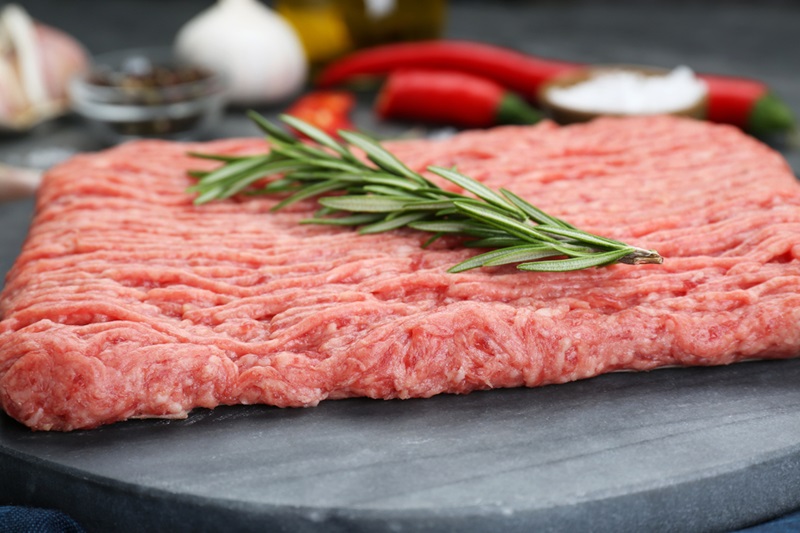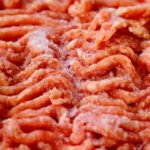Fresh minced beef is bright red in colour. However, raw mince can sometimes take on a brownish tone that looks less appetising.
This leaves many home cooks asking: Is mince safe to eat if it’s brown? Is the colour change merely a cosmetic shift or a signal of potential spoilage?
Here, we look at whether or not brown mince is safe to eat. We also give you the science behind the colour change, other signs of spoilage you can look for, and tips for storing and cooking mince safely.
So, is that brown mince on your kitchen counter a safe ingredient for your next meal or should it be thrown in the bin? Let’s find out!
Is Mince Still OK If It’s Brown?
Unfortunately, the question, “Is mince safe to eat if it’s brown?” doesn’t have a straightforward answer.
Usually, browned mince is safe to eat. However, there are times in which browning could indicate spoilage or bacterial growth, making it unsafe for consumption.
This is because rather than indicating spoilage, the brown colour indicates the age of the meat. Raw minced beef starts to brown if it is not exposed to oxygen.
The longer mince sits in its packaging, the less exposure to oxygen it has and the browner it becomes. Therefore, mince that has turned brown isn’t necessarily unsafe—it is just not super fresh.
As long as the meat has been stored correctly and within its use-by date, a little browning is nothing to worry about.
However, if there are any other signs of spoilage (such as unusual smells or textures) or the mince is brown all the way through, it is best to throw it away to avoid getting sick.
How Do You Know If Mince Is Off?
Colour is an important consideration when determining whether mince is safe to eat. However, as brown mince can be safe for consumption, colour alone is not enough to indicate whether your minced beef has gone off.
You must consider other factors using your senses—sight, smell, and touch—to assess its freshness.
Here are some signs that minced beef may be off:
- Unpleasant smell: Spoiled meat such as beef often has a distinct and unpleasant odour. If the minced beef has a sour, rotten, or off-putting smell, it may be an indication that it’s no longer safe to eat.
- Slimy texture: Fresh minced beef should have a relatively firm texture. If it feels slimy or sticky, it may be a sign of bacterial growth on the surface of the meat. Additionally, any changes in consistency are a sign that the meat is deteriorating.
- Past expiry date: Always check the expiration date on the packaging of the meat you buy. If the minced beef is past its expiration date, it’s safer to discard it than eat it, even if it looks, smells, and feels okay.
- Damaged packaging: If the packaging is damaged or compromised, there’s a higher risk of contamination. Examine the packaging for any tears, leaks, or other issues that may have allowed bacteria to enter. If so, throw the mince away.
Why Does Mince Turn Brown?
Beef meat contains myoglobin, a protein that carries oxygen to muscle cells. In fresh meat, the myoglobin is a deep burgundy colour. When exposed to oxygen in the air, it is converted into oxymyoglobin and turns red.
The mince found in supermarkets or butcher shops has already been exposed to air during the mincing process, which explains its usual red colour. This colour indicates that the meat is fresh.
However, unless exposed to more oxygen, the oxymyoglobin is converted into another type of myoglobin called metmyoglobin. This has a brown-grey pigment.
It is not uncommon for the meat below the surface or at the bottom of the packet to turn brown, even if the outer surface is red. This happens as the interior of the mince doesn’t have as much contact with the oxygen in the air.
Therefore, the myoglobin won’t be converted to red oxymyoglobin. When it comes into contact with the air, these brown parts usually turn red.
The older the mince is, the longer the underneath parts go without sufficient oxygen to activate the myoglobin and the browner they become.
Vacuum packed mince is likely to go brown as it is deprived of oxygen. This doesn’t mean the beef is no longer fresh. Once you open the pack, the redness should come back to the mince as it’s exposed to oxygen.
How Long Does Mince Last in the Fridge?

The shelf life of minced meat in the fridge depends on several factors, including the type of meat, how it’s packaged, and the temperature of your refrigerator. In general, here are some guidelines for storing minced meat in the fridge:
- Freshly ground meat: If you’ve just purchased or freshly ground the meat, it’s best to use or freeze it within 1 to 2 days. This ensures optimal freshness.
- Store-bought mince: If the minced meat is pre-packaged and purchased from a supermarket in the UK, it usually comes with a use-by date. Consume or freeze the meat by this date to ensure its safety and quality.
To maximise the shelf life of mince, you can also use some of these tips:
- Keep it in the coldest part of your refrigerator (usually at the back), ideally at or below 4°C.
- Store the mince in a sealed container or resealable bag to prevent exposure to air.
- If you don’t plan to use the minced meat within the recommended timeframe, consider freezing it. Mince can cooked from frozen and stored in the freezer for up to 4 months.
Is Mince Cooked When It’s Brown?

When minced meat is cooked, the myoglobin undergoes further chemical changes and changes from red to brown.
This is a normal and expected outcome and is a sign that the beef is cooked and ready to eat. When recipes call for “browning” mince in a slow cooker or pan, this is what they mean.
Although raw mince that is brown is usually safe to eat, it must be cooked through before eating.
However, the colour change that occurs during cooking can be harder to see in brown mince. This makes it more challenging to determine whether or not the mince is fully cooked.
When cooking raw brown mince, use a meat thermometer to check the internal temperature in the thickest part of the minced meat.
Ground meat should be cooked to an internal temperature of at least 71°C to ensure that harmful bacteria, such as E. coli or Salmonella, are killed. Once it reaches the recommended temperature, the meat is safe to eat.

Hannah is a freelance content writer and self-proclaimed foodie. When Hannah isn’t sitting tapping at her laptop, you’ll probably find her in the kitchen. As an ex-chalet host, she’s used to cooking four-course meals for 10+ people and loves feeding friends and family whenever possible.







